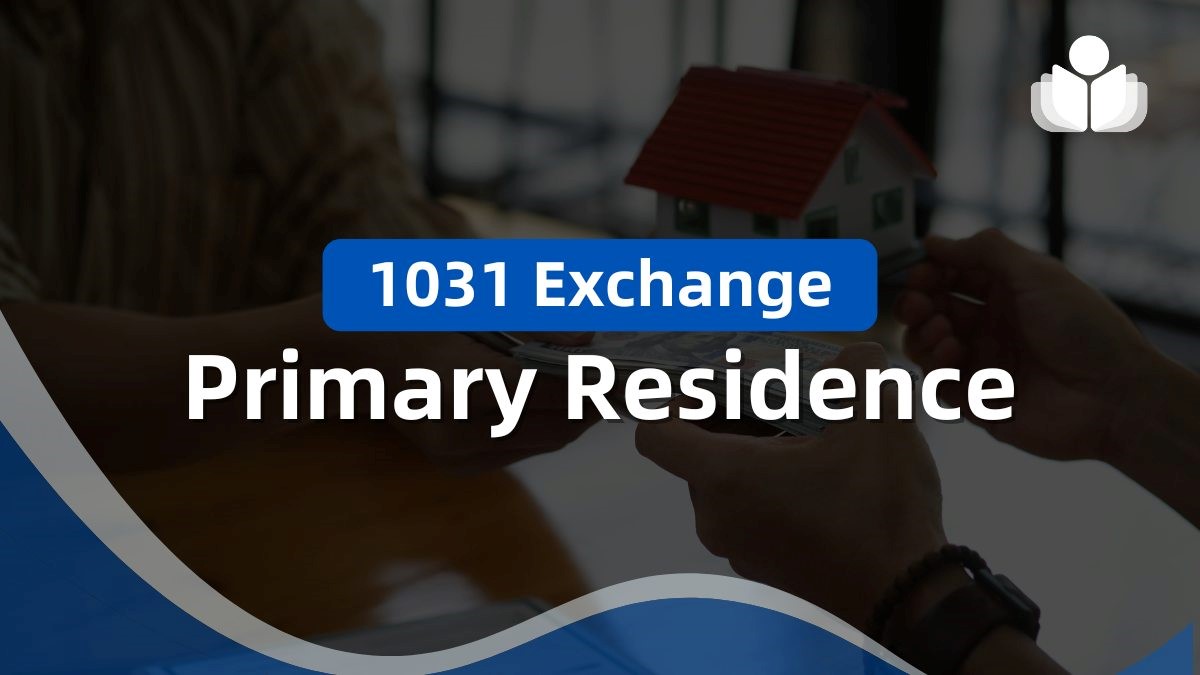A 1031 Exchange is a powerful tool in real estate investment, allowing investors to defer capital gains taxes when selling an investment property by reinvesting the proceeds into a similar, or “like-kind,” property. Traditionally, this strategy is used for investment properties like rental units, commercial buildings, or undeveloped land, enabling investors to build wealth and grow their portfolios without the immediate tax burden.
However, what if you want to use a 1031 Exchange involving your primary residence? The IRS has strict rules regarding what qualifies for a 1031 Exchange, and typically, a primary residence needs to meet the criteria since it’s not considered an investment property. However, some scenarios and strategies exist where a 1031 Exchange might still apply, even if your primary residence is involved.
This article aims to explore the possibilities and limitations of using a 1031 Exchange with a primary residence. We’ll delve into the specific IRS rules, potential strategies for converting a primary residence into a qualifying property, and the tax implications to consider. Understanding these nuances can help you make informed decisions about your property transactions, whether you’re a homeowner or a real estate investor.
What Is a 1031 Exchange?
A 1031 Exchange, named after Section 1031 of the U.S. Internal Revenue Code, is a tax-deferral strategy used by real estate investors. It allows the deferral of capital gains taxes when selling an investment property, provided the proceeds are reinvested into another “like-kind” property.
The primary purpose of a 1031 Exchange is to encourage continued investment in real estate by enabling investors to reinvest their gains into new properties without immediately incurring the tax liabilities that would typically arise from the sale.
Typical Use Cases
1031 Exchanges are commonly used in various real estate investment scenarios. Investors often utilize this strategy when selling rental properties, commercial buildings, or undeveloped land to acquire new properties that better fit their investment goals.
For example, an investor might sell a small apartment building and use the proceeds to purchase a larger commercial property, thus increasing their potential income and expanding their portfolio. Similarly, commercial real estate investors might use a 1031 Exchange to upgrade to more valuable property or diversify their holdings across different geographical locations.
Basic Requirements
To qualify for a 1031 Exchange, several key requirements must be met:
- Like-Kind Property Requirement: The property being sold and the property being purchased must be of “like-kind,” meaning they must be similar in nature or character, although not necessarily identical. For example, an investor can exchange an apartment building for a commercial property but not for stocks or personal items.
- Role of a Qualified Intermediary (QI): A Qualified Intermediary is essential in the 1031 Exchange process. The QI facilitates the exchange by holding the proceeds from the sale of the relinquished property and using those funds to purchase the replacement property on behalf of the investor. The investor cannot directly receive the proceeds from the sale, as this would disqualify the exchange.
- Key Deadlines: The IRS imposes strict deadlines on 1031 Exchanges. The investor has 45 days from the sale of the relinquished property to identify potential replacement properties and 180 days to complete the purchase of the replacement property. Missing these deadlines can result in the disqualification of the exchange, leading to immediate tax liabilities.
Primary Residence vs. Investment Property
A primary residence is defined by the IRS as the main home where an individual lives for the majority of the year. To qualify as a primary residence, the property must be where the homeowner spends most of their time, receives mail, registers to vote, and considers their primary dwelling.
The IRS considers various factors to determine whether a property is a primary residence, including the homeowner’s address on tax returns, driver’s license, and other official documents. Only one home can be designated as a primary residence at any given time.
Difference Between Primary Residence and Investment Property
The IRS distinguishes between a primary residence and an investment property based on how the property is used. A primary residence is a home where the owner lives most of the time, while an investment property is held for the purpose of generating income, appreciation, or both.
Investment properties can include rental properties, commercial real estate, and land held for future development. The key difference lies in the intended use of the property: a primary residence is for personal living, whereas an investment property is primarily for financial gain.
Tax Treatment of Primary Residence Sales
When a homeowner sells a primary residence, they may be eligible for the Section 121 exclusion, which allows them to exclude up to $250,000 (or $500,000 for married couples filing jointly) of capital gains from their taxable income.
To qualify for this exclusion, the homeowner must have owned and lived in the home as their primary residence for at least two of the five years preceding the sale. This tax benefit makes the sale of a primary residence particularly advantageous, as many homeowners can avoid paying any capital gains taxes on the sale.
Why Primary Residences Typically Don’t Qualify for 1031 Exchange
A primary residence generally doesn’t qualify for a 1031 Exchange because it’s not considered an investment property. The purpose of a 1031 Exchange is to allow investors to defer capital gains taxes when selling one investment property and purchasing another like-kind property. Since a primary residence is used for personal living and not for investment purposes, it falls outside the scope of the 1031 Exchange rules.
However, there are some scenarios where a property that was once a primary residence can be converted into an investment property and then used in a 1031 Exchange. For example, if a homeowner moves out of their primary residence and rents it out for a period of time, the property may qualify as an investment property. Once it meets the IRS requirements as an investment property, it could potentially be eligible for a 1031 Exchange upon sale.
Converting a Primary Residence to an Investment Property
Converting a primary residence into an investment property is a strategy some homeowners use to take advantage of the tax benefits associated with investment properties, including the possibility of using a 1031 Exchange. However, this process involves careful planning and adherence to IRS guidelines to ensure the property qualifies as an investment property.
Conversion Process
The first step in converting a primary residence into an investment property is to change the property’s use from personal to rental or investment. This typically involves:
- Vacating the Property: Move out of the property and find a new primary residence. Once you no longer live in the home, it becomes eligible to be rented out.
- Setting Up Rental Operations: Begin renting out the property to tenants. This includes advertising the property, screening potential tenants, and signing a lease agreement. It’s also important to set up proper accounting and record-keeping systems for tracking rental income and expenses.
- Documenting the Change in Use: Maintain detailed records that demonstrate the change in the property’s use, such as rental agreements, tenant correspondence, and evidence of rental income. These records will be crucial if the IRS questions the property’s qualification as an investment property.
IRS Requirements for Conversion
To qualify a converted property for a 1031 Exchange, the IRS requires that the property be held for investment purposes. This means the property must be rented out for a sufficient period to establish it as an investment property rather than a personal residence.
The IRS doesn’t specify an exact minimum rental period, but generally, the property should be rented out for at least one to two years before it can be considered for a 1031 Exchange.
Other conditions include:
- Intent: The homeowner must demonstrate that the intent behind the conversion is to hold the property for investment purposes, not for immediate resale or personal use.
- Rental Activity: The property must be actively rented out, meaning there should be consistent rental income and active management of the property.
Holding Period Considerations
The holding period refers to the length of time the property is held as an investment before it qualifies for a 1031 Exchange. While the IRS doesn’t provide a strict timeline, most tax professionals recommend holding the property as a rental for at least one to two years. During this period, the property should generate rental income, and the homeowner should continue managing it as an investment.
The longer the property is held and rented out, the stronger the case for it being considered an investment property by the IRS.
Tax Implications of Conversion
Converting a primary residence into an investment property has several tax implications:
- Depreciation: Once the property is converted, you can start depreciating it for tax purposes. Depreciation reduces your taxable income by accounting for the property’s wear and tear over time. However, if you later sell the property (even through a 1031 Exchange), you may be subject to depreciation recapture tax, which is taxed at a higher rate.
- Capital Gains Tax: If you convert your primary residence into an investment property and then sell it without a 1031 Exchange, you may owe capital gains taxes on the sale. However, if you lived in the property for at least two of the last five years before the sale, you may still qualify for the Section 121 exclusion, which allows you to exclude up to $250,000 ($500,000 for married couples) of capital gains.
- Section 121 and 1031 Exchange: If you meet the criteria for both the Section 121 exclusion and a 1031 Exchange, it may be possible to use both strategies. However, the IRS has specific rules on how these benefits can be combined, so it’s advisable to consult a tax professional.
Using a 1031 Exchange After Converting a Primary Residence
Eligibility for 1031 Exchange
To determine if your converted primary residence qualifies for a 1031 Exchange, you must ensure that the property meets the IRS requirements for an investment property. After converting your primary residence into a rental or investment property, the key factors to consider include:
- Holding Period: The property should be rented out and held for investment purposes for at least one to two years before initiating a 1031 Exchange. The longer the property is used as an investment, the stronger your case for qualifying it under 1031 rules.
- Intent: The intent behind holding the property must be for investment or productive use in a trade or business, not for personal enjoyment or short-term resale. Documenting the rental activity and management of the property is essential to demonstrate this intent.
Executing the Exchange
Once you’ve determined that your converted primary residence qualifies for a 1031 Exchange, follow these steps to execute the exchange:
- Engage a Qualified Intermediary (QI): Before selling your property, hire a QI to facilitate the exchange. The QI will hold the proceeds from the sale and ensure that the transaction complies with IRS rules.
- Sell the Converted Property: Proceed with the sale of your converted property. The proceeds must be transferred directly to the QI, not to you, to maintain the tax-deferred status of the exchange.
- Identify Replacement Property: Within 45 days of selling your property, identify potential replacement properties. You can identify up to three properties of any value or more if their combined value doesn’t exceed 200% of the sold property’s value.
- Purchase the Replacement Property: Complete the purchase of the replacement property within 180 days of selling your converted property. The QI will use the held proceeds to fund the purchase, finalizing the exchange.
Identifying Replacement Property
When selecting a new investment property under the 1031 Exchange rules, consider the following:
- Like-Kind Requirement: The replacement property must be of like-kind to the one sold, meaning it must be used for investment or business purposes. It can be residential, commercial, or land, but it must meet the IRS’s like-kind criteria.
- Value Considerations: The replacement property’s value should be equal to or greater than the value of the sold property to fully defer capital gains taxes. If the replacement property is of lesser value, you may face partial tax liability on the difference.
Tax Benefits of the Exchange
A 1031 Exchange allows you to defer paying capital gains taxes on the sale of your converted property. By reinvesting the proceeds into a new like-kind investment property, you can continue to grow your real estate portfolio without the immediate tax burden.
This deferral enables you to leverage the full sale proceeds for further investment, potentially increasing your wealth over time. By deferring capital gains taxes, you can strategically plan future exchanges or hold the new property for continued appreciation.
Mixed-Use Property and Partial 1031 Exchange
A mixed-use property is one that serves both personal and investment purposes. For example, a property may consist of a residential unit where the owner lives (primary residence) and a separate unit or space rented out to tenants or used for business purposes (investment property). These properties present unique opportunities and challenges when it comes to tax strategies like the 1031 Exchange.
Partial 1031 Exchange
When a mixed-use property is sold, only the portion of the property used for investment or business purposes qualifies for a 1031 Exchange. This is known as a partial 1031 Exchange.
The personal residence portion doesn’t qualify for the exchange and may instead be eligible for the Section 121 exclusion, which allows for the exclusion of up to $250,000 ($500,000 for married couples) of capital gains on the sale of a primary residence.
Calculating the Exchange
To determine the percentage of the property that qualifies for a 1031 Exchange, you must allocate the property’s value between its personal and investment portions. This can be done using one of the following methods:
- Square Footage: Calculate the percentage of the property’s total square footage used for investment purposes. For example, if 40% of the property’s square footage is rented out, then 40% of the property’s sale value would qualify for the 1031 Exchange.
- Income Allocation: Another method involves allocating the property’s value based on the income generated from the investment portion relative to the property’s total income potential.
The Section 121 Exclusion Combined with a 1031 Exchange
The Section 121 Exclusion allows homeowners to exclude up to $250,000 ($500,000 for married couples) of capital gains from the sale of their primary residence from taxable income.
To qualify, the homeowner must have owned and lived in the home as their primary residence for at least two of the five years preceding the sale. This exclusion provides significant tax relief for those selling their primary residence, reducing or eliminating capital gains tax liability.
Combining Section 121 With a 1031 Exchange
In some cases, it’s possible to combine the benefits of the Section 121 Exclusion with a 1031 Exchange, especially when dealing with a mixed-use property or converting a primary residence into a rental property before selling it.
How it works: The portion of the property used as a primary residence can qualify for the Section 121 Exclusion, while the portion used for investment purposes can be eligible for a 1031 Exchange. This combination allows homeowners to exclude a portion of the capital gains and defer taxes on the remaining gains by reinvesting in like-kind property.
Strategic Use of Both Provisions
A homeowner who converts their primary residence into a rental property can strategically use both the Section 121 Exclusion and a 1031 Exchange.
For example, if a homeowner lives in a property for two years and then rents it out for another two years before selling it, they can potentially exclude up to $250,000 ($500,000 for married couples) of the gain under Section 121 and defer the remaining gain on the investment portion through a 1031 Exchange. This strategy maximizes tax savings by taking advantage of both exclusions and deferrals.
Limitations and IRS Guidelines
When combining these tax strategies, it’s important to be aware of IRS guidelines and limitations:
- Proportional Use: The property’s use as a primary residence versus an investment property must be carefully documented to determine the applicable portion for each tax benefit.
- Two-Year Rule: To qualify for the Section 121 Exclusion, the homeowner must have lived in the property as their primary residence for at least two of the five years before the sale.
- Five-Year Rule: For properties converted from a primary residence to a rental, the Section 121 Exclusion can only be applied if the sale occurs within three years of moving out.
Potential Risks and Challenges
IRS Scrutiny
When using a 1031 Exchange with a former primary residence, there’s an increased risk of IRS scrutiny. The IRS closely examines transactions that involve properties previously used as primary residences, particularly to ensure that the property was genuinely converted to an investment property.
The IRS may audit these exchanges to verify that the property met the required holding period, was rented out for a sufficient time, and was not used for personal enjoyment during the period in question. Failure to provide adequate documentation or proof of the property’s investment use can result in the disqualification of the 1031 Exchange and the imposition of capital gains taxes.
Timing and Compliance Risks
Meeting the IRS’s timing and compliance requirements for a 1031 Exchange can be challenging. To qualify, the converted property must be held for investment purposes for a sufficient period, typically one to two years.
Strict deadlines apply, including the 45-day identification period and the 180-day closing period for purchasing a replacement property. Missing these deadlines or failing to comply with other IRS regulations, such as using a Qualified Intermediary, can result in the disqualification of the exchange and the loss of tax deferral benefits.
Loss of Primary Residence Exclusion
Converting a primary residence entirely into a rental property and then attempting a 1031 Exchange can lead to the loss of the Section 121 exclusion, which allows homeowners to exclude up to $250,000 ($500,000 for married couples) of capital gains from the sale of their primary residence.
If the property is fully converted and no longer partially used as a residence, the homeowner may forfeit this valuable exclusion, leading to a higher tax liability when the property is sold.
Market Risks
Market risks are another significant challenge when holding a property for a 1031 Exchange. Real estate market fluctuations during the holding period can impact the property’s value, potentially reducing the expected gains or even resulting in a loss.
If the market declines, the property might sell for less than anticipated, affecting the investor’s ability to reinvest in a like-kind property of equal or greater value. Additionally, changes in interest rates, local economic conditions, or property-specific issues could further complicate the timing and execution of the exchange.
Frequently Asked Questions
Conclusion
Using a 1031 Exchange with a primary residence offers significant tax benefits, particularly when converting the property into an investment. However, this strategy comes with risks, including IRS scrutiny, strict compliance requirements, and potential loss of the Section 121 exclusion.
To maximize the benefits and avoid pitfalls, it’s essential to carefully plan and adhere to IRS guidelines. Seeking professional advice is crucial to navigate these complexities and ensure the best outcomes when combining 1031 Exchange strategies with primary residence tax benefits.
 Sections of this topic
Sections of this topic
















